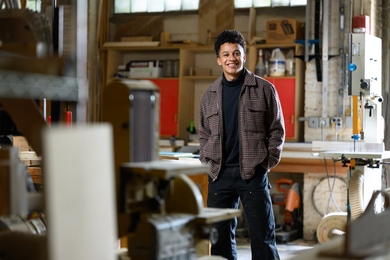A Japanese production of "King Lear" with an all-male cast, a film version of "Hamlet" with the Prince of Denmark as video artist and playful reedits of the balcony scene from "Romeo and Juliet" that become YouTube valentines--these are just three of the many multimedia and cross-media interpretations of William Shakespeare's work that a panel of scholars discussed at the MIT Communications Forum, "Remixing Shakespeare," on Feb. 15. As the participants made clear, reworking Shakespeare across many media is nothing new.
The forum was, in the words of Henry Jenkins, the John E. Burchard Professor of Literature, who introduced the participants, "an all home-team event, showcasing the literature faculty here at MIT." Acting as moderator was Mary C. Fuller, associate professor of literature.
Diana Henderson, professor of literature and dean for curriculum and faculty support, spoke first and set the stage with a discussion of multimedia and cross-media practices, historic and contemporary. She noted that Shakespeare himself was not confined to plays but also wrote lyric and narrative poetry, and furthermore that rewriting and co-writing were standard practice in the Elizabethan theater. "He was certainly not the genius figure/scriptural god that he became a few hundred years later," she said. Later, during the Restoration period, Shakespeare's plays and other classics were rewritten to suit contemporary tastes. Most notably, and notoriously, Nahum Tate rewrote "King Lear" to give it a happy ending: King Lear gets the throne back and Edgar and Cornelia pair up. It is easy to mock such efforts, Henderson observed, but the historical context is key: This plot change "speaks to a generation that has lived through, and perhaps may live through again, they think, the usurpation of the throne or the killing of the king."
The 19th and early 20th centuries abounded with Shakespeare experimentation, including musical versions, opera (by Verdi and Gounod, among others) and silent film. These genres, examples of which were screened at the forum, beg the question of whether it is still Shakespeare if (as in opera) the plot and words have been thoroughly revised, and (as in silent film) if there is no sound. Like Walter Scott's "Kenilworth" (a reworking of the Othello story), these remixes show that "contemporary versions, stories that are analogs to Shakespeare, start creeping back and forth in relationship to those texts that we call the 'canon,'" Henderson said.
Henderson pointed to recent film versions of Shakespeare to show "how malleable the boundaries of Shakespeare are and continue to be." Michael Almareyda's "Hamlet" with Ethan Hawke in the lead role (2000), another made-for-TV "Hamlet" starring Campbell Scott (2000) and Paul Mazursky's "Tempest" (1982), in which the Shakespeare script was jettisoned entirely, retaining only the characters and a parallel setting, show that "there are a lot of virtues in impurity."
Peter Donaldson, professor of literature, then took the podium, noting that he finds it useful to go back to some very old literary terms in thinking about remixing (in film, on the Internet, on stage), namely metaphor, conceit (extended and elaborated metaphor), and allegory. All of these concepts, like many of today's remixes (in hip-hop, for example), are about holding two things in mind or in view, at once independently and interactively.
He took up Almareyda's "Hamlet" in detail, focusing on Hamlet as videographer. Ethan Hawke's character is based in part on the persona of Kurt Cobain, evoking alienated youth culture. The young prince, heir to the Denmark Corporation, is shown filming his environs and his fellow characters, constantly editing the footage and reviewing it, in a disheveled room at the "Hotel Elsinore"--in short, displaying the kind of endless mulling-over for which his character is famous. Hamlet's video contains found footage of death and destruction (major themes of the play), as well as personal footage captured on a Fischer-Price PXL2000, a camera designed as a toy that has a kind of cult status among art-filmmakers, marking Hamlet as an individualistic voice unimpressed by glitz and greed. "The media use serves not only as a way for Ethan Hawke as Hamlet to meditate on his life but also cuts him off, in a more severe way than any other Hamlet I've seen, from the rest of the world around him," Donaldson said.
Other remixings Donaldson highlighted were Michael Hoffman's "A Midsummer Night's Dream" (1999), suffused with references to opera and self-consciously parading its anachronistic 19th-century setting, and playful or parodying works, of which there are hundreds posted on the Internet. He screened a remarkable clip of Peter Sellers, dressed and lighted in imitation of Lawrence Olivier's Richard III, ponderously reciting the lyrics to "A Hard Day's Night."
Remixing Shakespeare is alive and well. Said Henderson, "It's the reason why some of us find ourselves spending whole lifetimes looking at Shakespeare, not just because of a particular play text but because these four centuries of the remix allow you a reflection of culture at large."
A version of this article appeared in MIT Tech Talk on February 28, 2007 (download PDF).





